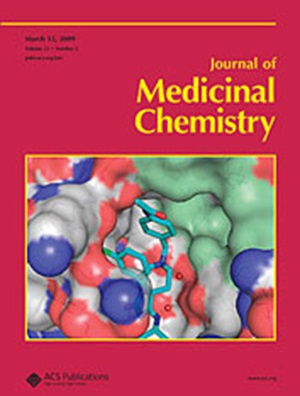Transforming Small-Molecule Nanoaggregation into Functional Drug Delivery Platforms
IF 6.8
1区 医学
Q1 CHEMISTRY, MEDICINAL
引用次数: 0
Abstract
The development of stimuli-responsive nanoaggregates offers a transformative approach to cancer therapy, addressing the challenges of selectivity and efficacy. The spontaneous formation of nanoscale aggregates of small organic molecules through self-assembly is a major hurdle in early-stage drug discovery. However, this disadvantage can be transformed with a meticulous design into a functional drug delivery platform. Here, we report Nano-CC1-Acl, a nanoaggregate engineered for targeted anticancer activity. CC1 and CC1-Acl, benzimidazole derivatives, undergo self-assembly in aqueous environments to generate Nano-CC1 (235.2 ± 28.2 nm; IC50 > 100 μM) and Nano-CC1-Acl (110.6 ± 23.1 nm; IC50 = 2.88–3.40 μM) nanoaggregates. The IC50 value of Nano-CC1-Acl further decreases to 0.20 ± 0.16 μM in the presence of cysteine, a biothiol. Triggered by intracellular biothiols, Nano-CC1-Acl disassembles to release CC1, a potent microtubule-targeting agent that disrupts microtubule polymerization. Results presented here indicate that small molecule nanoaggregation can be utilized to develop functional drug delivery platforms.

将小分子纳米聚集转化为功能药物传递平台
刺激反应纳米聚集体的发展为癌症治疗提供了一种变革性的方法,解决了选择性和有效性的挑战。小有机分子通过自组装自发形成纳米级聚集体是早期药物发现的主要障碍。然而,这个缺点可以通过细致的设计转化为功能性的给药平台。在这里,我们报道了纳米cc1 - acl,一种用于靶向抗癌活性的纳米聚集体。苯并咪唑衍生物CC1和CC1- acl在水环境中自组装生成纳米CC1(235.2±28.2 nm;IC50祝辞100 μM)和Nano-CC1-Acl(110.6±23.1 nm;IC50 = 2.88-3.40 μM)纳米聚集体。在半胱氨酸(一种生物硫醇)的存在下,纳米cc1 - acl的IC50值进一步降低至0.20±0.16 μM。由细胞内生物硫醇触发,纳米CC1- acl分解释放CC1,一种有效的微管靶向剂,破坏微管聚合。本研究结果表明,小分子纳米聚集可以用于开发功能药物传递平台。
本文章由计算机程序翻译,如有差异,请以英文原文为准。
求助全文
约1分钟内获得全文
求助全文
来源期刊

Journal of Medicinal Chemistry
医学-医药化学
CiteScore
4.00
自引率
11.00%
发文量
804
审稿时长
1.9 months
期刊介绍:
The Journal of Medicinal Chemistry is a prestigious biweekly peer-reviewed publication that focuses on the multifaceted field of medicinal chemistry. Since its inception in 1959 as the Journal of Medicinal and Pharmaceutical Chemistry, it has evolved to become a cornerstone in the dissemination of research findings related to the design, synthesis, and development of therapeutic agents.
The Journal of Medicinal Chemistry is recognized for its significant impact in the scientific community, as evidenced by its 2022 impact factor of 7.3. This metric reflects the journal's influence and the importance of its content in shaping the future of drug discovery and development. The journal serves as a vital resource for chemists, pharmacologists, and other researchers interested in the molecular mechanisms of drug action and the optimization of therapeutic compounds.
 求助内容:
求助内容: 应助结果提醒方式:
应助结果提醒方式:


